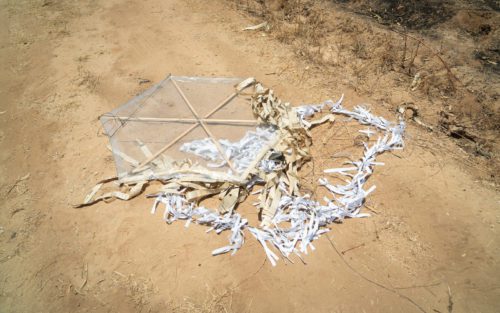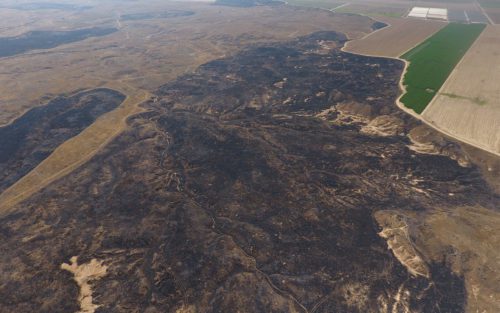
As kite-set fires engulf the south, foresters fight to ‘save every tree’
More than 17,500 dunams burned in Gaza periphery, majority in parks and conservation areas, destroying groves planted decades ago
Usually, the strong western breeze that comes from the Mediterranean into the Beeri nature reserve, on the border with Gaza, is a welcome respite from the desert heat. But these days, when the wind picks up from the west, Dani Ben David casts his eyes skyward and pulls out his walkie-talkie, waiting for reports of the next fire.
As the director of the Western Negev Region for Keren Keyemet L’Yisrael/Jewish National Fund, Ben David has watched thousands of dunams burn over the past six weeks from the incendiary kites coming over the border from Gaza.
There have been at least 285 separate fire incidents in the KKL/JNF nature reserves since April 11, burning 3,000 dunams (740 acres) of conservation area in the Beeri and Kissufim forests, Ben David said. According to the Nature and Parks Authority, a total of 10,000 dunams in parks and reserves in southern Israel have been torched, including the KKL/JNF parks. Fires also burned an additional 7,500 dunams (1,800 acres) of farmland, mostly cattle grazing areas but also parts of some fields.
On Sunday, Prime Minister Benjamin Netanyahu ordered that funds be withheld from the Palestinian Authority to compensate Israeli farmers living on the Gaza border whose agricultural lands were destroyed.
Israel’s Tax Authority said the agricultural damage alone stood at NIS 5 million ($1.4 million) and that damage caused to nature reserves and other land could drive up the figure.
On Tuesday, KKL/JNF announced the organization plans to sue Hamas in international court for damages incurred in the fires.
“It is inconceivable that the international community would allow Hamas not to be held accountable and pay for its criminal acts — not only against the citizens of the state of Israel, but also against the environment, which has been severely hurt by this criminal environmental terrorism,” said KKL-JNF world chairman Daniel Atar after touring the damaged area on Tuesday.
“Hamas has proven it has no humanity,” Atar added. “Not just toward human beings, but also toward animals and natural resources.”
Kites made of newspapers, children’s homework
Some of the kites were still strewn across the forest floor this week, having landed harmlessly in areas that were previously burned. Ben David picked up one of the kites, whose tail is made of strips of newspapers and children’s homework. The kites are uniform, with the same hexagonal shape and balsa wood construction.

“Look at this, it takes just 10 minutes to make this, and costs, I don’t know, maybe a few shekels, and it creates hundreds of thousands of dollars of damage,” he said, as his shoes crunched over the scorched forest floor.
Ben David said the uniformity of the kites proves that this is a concerted terror effort and not just a hodge-podge activity for bored children.
Recently, a new arson tactic has been gaining popularity along the Gaza border. Instead of kites, a different children’s toy is being flown into Israel: helium balloons. The balloons have flaming materials tied to their ends, which start fires.

The IDF has been attempting to take down both kites and balloons with drones, with some success. But they keep coming.
‘We’re fighting for every tree’
The forests in the Gaza periphery area are not naturally occurring forests. Although the area did have many trees, most were cut down during the Ottoman era. In the 1960s and 1970s, the local kibbutzim and moshavim started planting thousands of drought-resistant eucalyptus, pine, and mesquite trees, creating a network of small forests.
The area is famous for the explosion of red anemones (kalaniyot) every winter, when the carpet of red flowers draws tens of thousands of Israelis to the region for the Darom Adom festival. The Darom Adom (Red South) festival is one of the largest economic engines for tourism in the area. But the forests of the Gaza periphery draw visitors year-round, and host some of the best mountain biking tracks in the country.
Because the forests are not naturally occurring, each grove is like a closed ecosystem that doesn’t connect geographically to a larger forest. This means that when a grove catches fire, all of the animals there at the time are trapped. While putting out fires, local foresters have found dozens of dead turtles, snakes, and lizards.
“In the agricultural areas, they’ll be able to plant again in the winter,” Ben David said. “But with forests, you need to wait and see. Only after the winter rain will we know how many trees we lost.”
Only a few years after the fire will KKL/JNF begin planting trees again. It takes eucalyptuses 15 years to grow to their full height, though the eucalyptus trees have a better chance of surviving the fires.
In the 2014 Gaza war, more than 3,500 dunams (865 acres) of conservation land and parks burned, mostly due to rockets shot from Gaza. Ben David said seeing the fires a second time didn’t make it easier, although they know better what to expect.
“With Operation Protective Edge, we knew the fires would end when there was a ceasefire,” he said. “But we don’t know how this will end. In the meantime, we’re fighting for every tree.”
Fifteen KKL employees from the southern region are dedicated full time to dealing with the fires, which break out on a near-daily basis. The worst day thus far saw 22 fires, while Tuesday’s Naksa Day had 15 fires.
At least 10 full-time firefighters are on the scene, rushing from grove to grove, using high pressure hoses to make sure that fires have been totally extinguished. The smell of smoke hangs heavy in the air.
Ben David said it’s difficult to see the kites, made from clear plastic, in the sky, and they often have difficulty tracking them.
On Sunday, the heads of the local governments in the Gaza periphery sent a letter to Netanyahu, Finance Minister Moshe Kahlon and Interior Minister Arye Deri calling for increased investment in the area in light of the precarious security situation.
“In the past week, including last night, almost 200 mortar shells and Qassam rockets have landed in Gaza periphery communities, serving as a painful reminder that the Gaza periphery must manage a fragile and complicated way of life, under constant threat to its residents,” the local mayors wrote.
The Nature and Parks Authority has employees on guard duty stationed on hilltops across the south, using binoculars to scan the sky in hopes of tracking where the kites will fall.
The parks authority also has a Belgium shepherd dog trained to sniff out fires. Smokey Jack and his handlers patrol the area, looking for parts of the fires that weren’t properly extinguished and could reignite.
Among the torched groves, memorials
“It might look black right now, but this blackness won’t break us; we will make it green by next year,” said Rafi Babayan, the head of security for the Sdot HaNegev regional council, as he stood in a charred Beeri Crater, next to Kibbutz Alumim. Scraps of childrens’ homework, parts of a kite, lie scattered across the area. “The bird flew away,” reads one scrap, caught in the tendrils of blackened grass, twisting in the wind.
The same wind that pushes the kites from Gaza into Israel also propel the flames quickly across an area. This means the fires burn larger swaths but move quickly before they have a chance to kill all of the plants. Animals that are able to hide in deep burrows, including snakes, may have survived the fires.
There is a part of the forest that has a special place in Babayan’s heart: Marva’s Well, an area of the Beeri forest named after his daughter, who died of cancer at age 18, just after Operation Protective Edge.
“When I heard on the radio that Marva’s Well was on fire, I raced over there,” he said. “On the way over there, it was difficult, I was thinking a lot of thoughts. But when I got there, I saw all the people who ran to came to help me from all over, and I was so proud.”
About 15 dunams (4 acres) of Marva’s Well burned before firefighters contained the fire.
“Every grove is important to us, and we are sad that it burns,” said Babayan. “But we are even sadder to look into the eyes of the farmers who have lost whole fields, and into the eyes of the foresters who planted these trees.”
Ben David has worked for KKL/JNF for 30 years, and his father also worked for KKL/JNF for 40 years. Ben David said as a child he knew personally many of the foresters who planted the large groves of trees in the area. Some have since died, but others are watching their entire life’s work go up in smoke.
From a memorial outlook dedicated to Australian and New Zealand soldiers who fought in the area in WWI, there is a view of Gaza City and the Mediterranean Sea beyond. Ben David gazes over acres of blackened forest.
“We’re used to talking about the Red South [Darom Adom], but now we’re talking about the black south,” he said, as his walkie-talkie crackled with reports of another fire, and smoke rose. One unintended consequence is that the fires might actually be good for the kalaniyot flowers at the next Darom Adom Festival.
Kalaniyot are geophytes, meaning their seeds look like onions and are protected below the ground. They compete with grasses for dominance. Since the fire wiped out the grasses, the kalaniyot will have no competition as and are expected to blanket the hills with red next January with a renewed ferocity.
From the outlook, Gaza is close enough to touch. A massive Gazan garbage pile sits just a few hundred meters away, and beyond that, the Mediterranean sparkles.
“Nature doesn’t care who is the enemy,” said Ben David. “As a forester, it’s sad for me to see every tree that dies. But nature doesn’t understand political status. Nature always suffers, it’s always the biggest loser.”
Source: The Timed of Israel